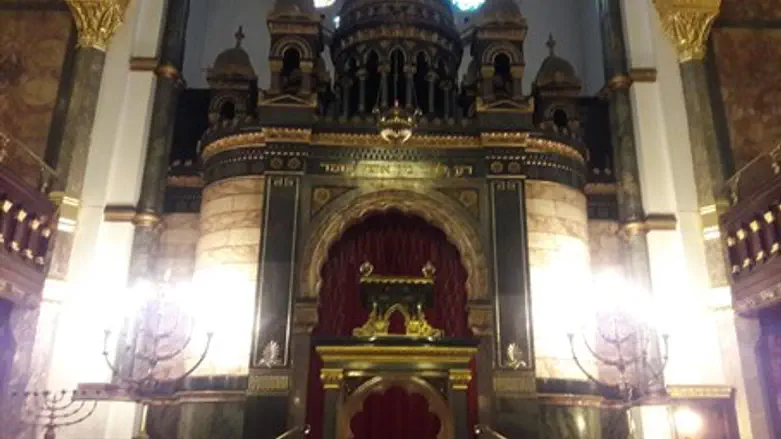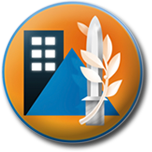
What do Israel's first President Chaim Weizman, former UK Home Secretary Herbert Samuel, the Rothchilds and the Montigues have in common?
All of these prominent Jewish individuals were members, at one time or another, of the New West End Synagogue in London, one of the oldest Jewish places of worship still in use in the UK.
A Grade 1 listed building (one of only three British synagogues to have gained that status), it boasts not only a rich history but a visually impressive, distinctly Victorian architecture - and a truly breathtaking interior. (You can view it for yourself online thanks to the Synagogue360 website.)
It was formally opened in 1879 and its foundation stone was laid two years previously by one Leopold de Rothschild, whose family were among the first congregants.
But unlike the many other equally beautiful, centuries-old synagogues dotted throughout Europe, the New West End Synagogue is no relic of the past. True, it no longer fills all 800 seats, but the synagogue still has some 450 active members, holds regular services every Shabbat and on all festivals, and has shacharit morning services on weekdays when they achieve the required quorum of 10 men.
An Ashkenazic, Orthodox synagogue, it is run with typical British efficiency by its Rabbi Dr. Moshe Freedman, Chairman Henry Magrill, shamash Eli Ballon and a Board of Directors.
Dr. Trevor Toube, a member of the Board (and father of the Board's Vice-Chair, Felicity Miller), showed Arutz Sheva around this "historically important" shul.
"Historically it's very important, because among the early members were many major Jewish figures - like the Rothchilds and the Montigues - the aristocracy of Victorian Judaism," Toube explained.
Another well-known former member was none other than Herbert Samuel, a Liberal Party politician and the first nominally-practicing Jew to serve as British Cabinet Minister, under Prime Minister Herbert Henry Asquith. Among other positions, Samuel served for a time as British Home Secretary. He is believed to have been a key driving force behind the 1917 Balfour Declaration, which helped pave the way to Jewish independence in Israel, and was appointed High Commissioner of Palestine in 1920, following the end of the Ottoman occupation.
One of the synagogue's former Rabbis was Louis Jacobs, who, after after his ties with the synagogue were severed following the so-called "Jacobs Affair," went on to found the Masorti Movement.
But perhaps the most famous individual to have owned a seat in the synagogue was Chaim Weizmann. A member in the 1930s, Weizmann - who would eventually go on to become the first President of the State of Israel - was at that time "a little-known biochemist from Imperial College," as Toube put it.
With such an illustrious history, it is no wonder that the New West End Synagogue played such a central role in the history of British Jewry. Its first Rabbi, Simeon Singer, compiled the Singer's Prayerbook, which is still in use today, and the shul's first choirmaster, D M David, also played a key role in formalizing the British-Jewish prayer rote, or Minhag Anglia.
Apart from its glorious past, Toube - who moved to the UK from South Africa 54 years ago - says the synagogue still has plenty of more modern attractions.
For a start, it is the only Orthodox synagogue in the UK which hosts a choir every week during Shabbat services. More importantly, it is an "astonishingly friendly community," where "people will just walk up to you and introduce themselves and make you feel at home."
Despite that, the shift in British Jewish demographics over the past several decades has not been favorable to the New West End Synagogue. The epicenter of the London Jewish community moved out into the suburbs, while the synagogue's prime location in central London's West End means young families are largely priced out.
That said, membership is "stable," says Toube, and while broadly "oldish," there are still a significant number of younger members.
And the New West End Synagogue has another secret as well: cooperation. "We hold regular joint events with the two other major central London synagogues nearby - Central Synagogue and Marble Arch Synagogue - including talks, shiurim, and other events," said Toube.
"We also work a lot with a nearby Sephardic shul, Holland Park. We had a joint Friday night service and event with them for the recent Shabbat UK, and we share a cheder with them - I think it's the only official joint Sephardic-Ashkenazic cheder in the UK."
All things considered, Toube says he and his fellow Board members are confident for the future - and they're urging people to visit and take part.
"On Shabbat morning we have between 70 to 80 people - if you're here for Shabbat, the likelihood is that you will get called up at least for psicha, and we have a lovely kiddush afterwards.
"But on weekday mornings we struggle for a minyan," he says. "It would be nice to get back to here we were a couple of years ago; to have a minyan every morning."
It's out of the way for religious Jews working in the City, but if you ever have an appointment in the West End, the free breakfast is as good an incentive as any to stop off at the New West End Synagogue for shacharit.
Service timetables can be viewed here.
